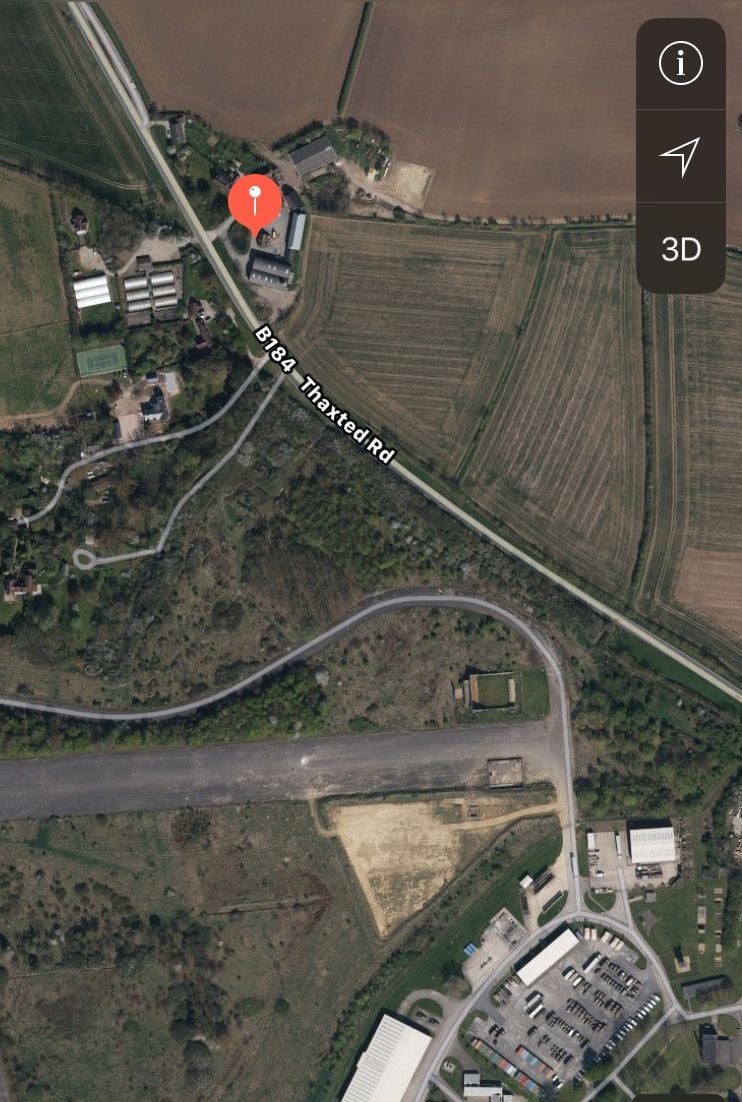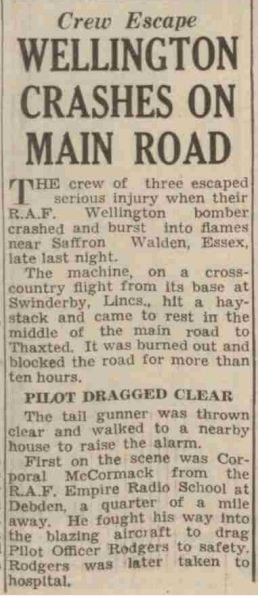Wellington crash 1950, Essex
Thread Starter
Wellington crash 1950, Essex
All,
I wonder if anyone could offer any more information on the crash of a RAF Vickers Wellington in Essex in July 1950. I *think* it happened near Wimbish, or maybe Saffron Walden (same place?). I have seen a brief mention that it was 10th July 1950, but that date comes from the UK Gazette so I'd like to think that it was correct.
I am trying to find out which aircraft was involved, which unit/squadron, and a more precise location. It could also be a few days either side of the 10th July.
I have been trawling around various internet sites relating to crashes, but I cannot find anything that matches. To be honest, I was most surprised to read that it was a Wellington flying in 1950!, I thought that they would all be long gone/grounded by then.
Thanks ... over to you ...
I wonder if anyone could offer any more information on the crash of a RAF Vickers Wellington in Essex in July 1950. I *think* it happened near Wimbish, or maybe Saffron Walden (same place?). I have seen a brief mention that it was 10th July 1950, but that date comes from the UK Gazette so I'd like to think that it was correct.
I am trying to find out which aircraft was involved, which unit/squadron, and a more precise location. It could also be a few days either side of the 10th July.
I have been trawling around various internet sites relating to crashes, but I cannot find anything that matches. To be honest, I was most surprised to read that it was a Wellington flying in 1950!, I thought that they would all be long gone/grounded by then.
Thanks ... over to you ...
Join Date: Sep 2011
Location: England
Age: 57
Posts: 77
Likes: 0
Received 0 Likes
on
0 Posts

The aforementioned New House Farm (as shown by the red marker) appears to be very close to the end of Debden main runway.
Last edited by Wyvernfan; 31st Dec 2018 at 22:46.
Thread Starter
All,
thanks for the info, especially Quemerford (for the clippings) and Wyvernfan (for the map).
In the early 70s when I was at school our PE teach was a Polish guy. It never occurred to me that, given his age at the time, he may of had a wartime history; it also never occurred to me to question why he was in the UK. Hindsight is a wonderful thing.
Very shortly before I finished school I discovered that the name we all knew him by was not his real name ... we knew him by an anglicised and shortened name.
Somebody bought him along to a school reunion in the late 90s, and although he was quite frail he was still quite alert and happy to talk to us all. He also showed some of us his old wartime ID card.
Sadly, he died in 2017, and his ashes were returned to Poland for burial; apparently he was quite a national hero over there!
Subsequent research, and I found the - Viewing Image: Alfons Mackowiak - Special Forces - Roll Of Honour
He also has a Polish Wikipedia page dedicated to him - https://pl.wikipedia.org/wiki/Alfons_Ma%C4%87kowiak
However, he was also a hero for a selfless rescue of crewmen from a crashed Wellington bomber in July 1950 - https://www.saffronwaldenreporter.co...life-1-4831795 - which is why I asked my original question.
So, any suggestions how to identify the aircraft involved, or the unit/squadron?
I have a vague recollection of a book listing UK aircraft losses, but I have no idea of a title, so I can't search for it. So, if such a book does exist, and if anyone does have a copy, is there anything else shown about this unfortunate crash.
thanks for the info, especially Quemerford (for the clippings) and Wyvernfan (for the map).
In the early 70s when I was at school our PE teach was a Polish guy. It never occurred to me that, given his age at the time, he may of had a wartime history; it also never occurred to me to question why he was in the UK. Hindsight is a wonderful thing.
Very shortly before I finished school I discovered that the name we all knew him by was not his real name ... we knew him by an anglicised and shortened name.
Somebody bought him along to a school reunion in the late 90s, and although he was quite frail he was still quite alert and happy to talk to us all. He also showed some of us his old wartime ID card.
Sadly, he died in 2017, and his ashes were returned to Poland for burial; apparently he was quite a national hero over there!
Subsequent research, and I found the - Viewing Image: Alfons Mackowiak - Special Forces - Roll Of Honour
He also has a Polish Wikipedia page dedicated to him - https://pl.wikipedia.org/wiki/Alfons_Ma%C4%87kowiak
However, he was also a hero for a selfless rescue of crewmen from a crashed Wellington bomber in July 1950 - https://www.saffronwaldenreporter.co...life-1-4831795 - which is why I asked my original question.
So, any suggestions how to identify the aircraft involved, or the unit/squadron?
I have a vague recollection of a book listing UK aircraft losses, but I have no idea of a title, so I can't search for it. So, if such a book does exist, and if anyone does have a copy, is there anything else shown about this unfortunate crash.
Assuming the reports that the Wellington was based at Swinderby are correct, the only unit operating Wellingtons there in 1950 was 201 Advanced Flying School (formerly 201 Conversion Training Unit and, before that, 17 Operational Training Unit).
As you're in West London, you're ideally placed to call in at Kew and look at the unit's ORB, which will almost certainly identify the aircraft involved.
Join Date: Jul 2007
Location: Was Doylestown, PA, now Arnhem, NL
Age: 73
Posts: 130
Likes: 0
Received 0 Likes
on
0 Posts
My records show the following;
RP323 Wellington T10 of 201 AFS from RAF Swinderby. Burst into flames over Saffron Walden, Essex and in the emergency landing that followed the aircraft hit a hay stack and came to rest in the middle of the main road to Thaxted near Newhouse Farm. The Wellington was burnt out and the road was closed for 10hrs.
I have often wondered if any pictures of the incident are out there. It would be interesting to see them if they are available.
QP
RP323 Wellington T10 of 201 AFS from RAF Swinderby. Burst into flames over Saffron Walden, Essex and in the emergency landing that followed the aircraft hit a hay stack and came to rest in the middle of the main road to Thaxted near Newhouse Farm. The Wellington was burnt out and the road was closed for 10hrs.
I have often wondered if any pictures of the incident are out there. It would be interesting to see them if they are available.
QP
Join Date: Mar 2007
Location: Hertfordshire
Age: 70
Posts: 292
Likes: 0
Received 0 Likes
on
0 Posts
Another source might be the RAF Museum Hendon who have 'Crash Cards' which summarise any reports on the incident. Give them the date, aircraft number and type.
Join Date: Jul 2007
Location: Auckland, NZ
Age: 79
Posts: 722
Likes: 0
Received 0 Likes
on
0 Posts
The first thing I thought when I saw the reports was that hitting a haystack meant seriously low flying. More probably, I suppose, the haystack was hit in the course of an emergency landing, but if the first interpretation is right, that could account for some accidents.
The civilian version of the Wellington, the Vickers Viking, whose production overlapped, lasted in service until 1968, when the last were withdrawn by Invicta Airways of Manston. It used the same wings, undercarriage, engines etc, with a different passenger-cabin fuselage.
"Mildly" Eccentric Stardriver
The fine Vickers lineage. When my young F/Os asked what a Varsity was (I'm an ancient aviator), I used to tell them it was "an aluminium-skinned Wellington, with a nose wheel". Not truly accurate, but it gave the idea. I stopped after one young man asked "what's a Wellington?" No sense of history, these whippersnappers.
Just a trivia aside, but did the Viking and Varsity still have the geodetic internal and wing structure of the Wellington, just with a metal instead of canvas skin, or was the structure completely redesigned with the change of outer skin ?
I believe that Farnborough were still running a Varsity (a further-tweaked Viking, for military service again) into the early 1990s.
I believe that Farnborough were still running a Varsity (a further-tweaked Viking, for military service again) into the early 1990s.





